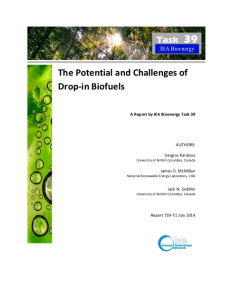Full Title: The Potential and Challenges of Drop-in Biofuels
Author(s): Sergios Karatzos
Publisher(s): IEA Energy Technology Network
Publication Date: July 1, 2014
Full Text: Download Resource
Description (excerpt):
This report was commissioned by IEA Bioenergy Task 39 with the goal of providing a background to the topic, an assessment of technical approaches being developed and an overview of anticipated challenges in large scale commercialization of so called “drop-in” biofuels. For the purposes of this report, “drop-in” biofuels are defined as “liquid bio-hydrocarbons that are functionally equivalent to petroleum fuels and are fully compatible with existing petroleum infrastructure”.
The global petroleum industry is expected to require increasing amounts of hydrogen in the coming years to upgrade crude oil feedstocks of declining quality (i.e., increasingly heavier and more sour), particularly in areas where especially heavy oils are being sourced such as Venezuela and Alberta. For the foreseeable future, much of this hydrogen is likely to be derived from natural gas. At the same time, there will also be increasing demand for hydrogen to deoxygenate biomass (carbohydrates and lignin) to produce drop-in hydrocarbon biofuels.
